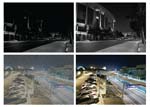
Getting the Most from Low Light
Bringing you up to date on changes in camera technology
- By Dave Smith
- Dec 01, 2009
System designers, installers and end users have experienced the
frustration that comes when cameras fail to work well in lowlight
conditions, producing grainy, noisy video. The video compression
used in most IP cameras and DVRs depends on the fact that
there is little change in most scenes over time. MPEG and H.264 are
able to squeeze data out of the video for areas of the picture that
don't move, saving bandwidth and valuable disk storage space. When
the picture gets noisy, the compression engine sees the noise as motion,
and network bandwidth and hard drive use increase dramatically,
causing increased transmission and storage costs.
Recent camera technology has improved the ability to provide good
quality video in low-lighting situations.
Newer cameras include an amplifier known as automatic gain
control. However, when the AGC boosts the signal, it also boosts
noise and eventually the noise makes it impossible to see any picture.
Most cameras allow you to set the maximum level of AGC. Experiment
with this setting. Setting the AGC to low means less noise,
but the picture will get washed out sooner as lighting fades. Setting it
higher, the camera will see better, but it will get noisier.
Here are a few tips to help you sort through the options:
Select a camera that offers high performance in low light. Look
at the minimum illumination specifications, but do your own comparisons
to find the camera that works best. There are no standards
for measuring minimum illumination so manufacturer's specifications
are only a general guide. Look for features such as frame integration
or Sens-up. Avoid wide dynamic range models unless you have a specific need as most WDR cameras are not as sensitive in low light.
Select a camera model with day/night capability. Day/night cameras
switch from color during the day to black and white at night to
provide the best picture quality for the lighting condition. The simplest
form of a day/night camera is known as electronic day/night.
When it switches to night mode, this type of camera shuts down the
color signal, which contains most of the noise. Without it, the camera
can apply more AGC boost to overcome the poor video contrast.
True day/night or infrared cut filter removal cameras turn off the
color signal and physically remove a filter, located between the lens
and the image sensor. In color mode, this filter must be in front of
the imager in order to produce proper color. In night mode, removing
the filter allows IR light and more visible light to reach the sensor. A
true day/night or ICR camera costs more but has significantly more
sensitivity than an electronic day/night camera. If you use an IR light
source, a true day/night camera is required.
Select a lens with the lowest f/stop rating. A one f/stop change
means double or half the light coming through the lens, so an f/1.0
lens is twice as good as an f/1.2 lens. Generally, adjust the f/stop to
just below the point where the whitest parts of the picture start to
bloom and wash together.
Use frame integration or Sens-up. Frame integration is another
good way to improve light sensitivity. You can make up for lower light
levels by increasing exposure time. Video cameras were traditionally
stuck with a fixed exposure time of 1/60th of a second due to television
standards. Now, cameras with frame integration are capable of
lengthening the exposure time to multiples of one TV field by storing
the exposed picture and refreshing it slower.
If Sens-up is set to x2—two fields—the exposure time goes from
1/60th of a second to 1/30th of a second. The refresh rate of the video
changes from 60 to 30 fps, thereby doubling the cameras' sensitivity.
Going to x4 mode makes this 15 fps, and x6 makes it 10 fps.
The disadvantage is that longer exposures have less ability to freeze
moving objects. On tight views with rapidly moving objects, the images
will blur. Cameras with frame integration will go to much longer exposures
than are practical in security applications, but some will allow
you to program a maximum value for Sens-up. As light levels decrease,
the camera will increase Sens-up until this maximum is reached. Setting
the maximum Sens-up value to x6 is safe for most applications
and provides a dramatic improvement in light sensitivity.
Use digital noise reduction. Some newer cameras offer digital noise
reduction for low-light applications. If more noise is removed, the
AGC boost can be increased to allow operation in lower light levels.
Higher levels of noise reduction often result in motion artifacts.
Whether you are using IP or analog cameras, paying attention to
the performance features should dramatically improve the quality of
video while reducing network load and storage requirements
by as much as 70 percent. A few hours
spent testing these features and comparing available
cameras will result in big benefits for the end user.